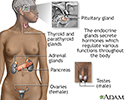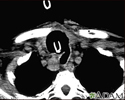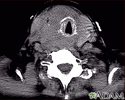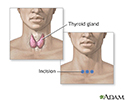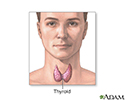Thyroid cancer
Tumor - thyroid; Cancer - thyroid; Nodule - thyroid cancer; Papillary thyroid carcinoma; Medullary thyroid carcinoma; Anaplastic thyroid carcinoma; Follicular thyroid cancer
Thyroid cancer is a cancer that starts in the thyroid gland. The thyroid gland is located inside the front of your lower neck.
Causes
Thyroid cancer can occur in people of any age.
Radiation increases the risk of developing thyroid cancer. Exposure may occur from:
- Radiation therapy to the neck (especially in childhood)
- Radiation exposure from nuclear plant disasters
Other risk factors are a family history of thyroid cancer and chronic goiter (enlarged thyroid). Being overweight or having obesity may be a risk factor for papillary carcinoma of the thyroid.
There are several types of thyroid cancer:
- Anaplastic carcinoma (also called giant and spindle cell cancer) is the most dangerous form of thyroid cancer. It is rare, and spreads quickly.
- Follicular tumor is more likely to come back and spread.
- Medullary carcinoma is a cancer of non-thyroid hormone-producing cells that are normally present in the thyroid gland. This form of thyroid cancer tends to occur in families.
- Papillary carcinoma is the most common type, and it usually affects women of childbearing age. It spreads slowly and is the least dangerous type of thyroid cancer.
Symptoms
Symptoms vary depending on the type of thyroid cancer, but may include:
- Cough
- Difficulty swallowing
- Enlargement of the thyroid gland
- Hoarseness or changing voice
- Neck swelling
- Thyroid lump (nodule)
Exams and Tests
Your health care provider will perform a physical exam. This may reveal a lump in the thyroid or swollen lymph nodes in the neck.
The following tests may be done:
- Calcitonin blood test to check for medullary thyroid cancer
- Laryngoscopy (looking inside the throat using a mirror or flexible tube called a laryngoscope placed through the mouth) ;to assess vocal cord function
- Thyroid biopsy, which may include genetic testing of the cells obtained in the biopsy
- Thyroid scan
- TSH, free T4 (blood tests for thyroid function)
- Ultrasound of the thyroid and the lymph nodes of the neck
- CT scan of the neck (to determine the extent of the cancerous mass)
- PET scan
Treatment
Treatment depends on the type of thyroid cancer. Treatment of most thyroid cancer types is effective if diagnosed early.
Surgery is most often done. All or part of the thyroid gland may be removed. If your provider suspects that the cancer has spread to lymph nodes in the neck, these will also be removed. If some of your thyroid gland remains, you will need follow-up ultrasound and possibly other studies to detect any regrowth of thyroid cancer.
Radiation therapy may be done with or without surgery. It may be performed by:
- Taking radioactive iodine by mouth
- Aiming external beam (x-ray) radiation at the thyroid
After treatment for thyroid cancer, you must take thyroid hormone pills for the rest of your life. The dosage is usually slightly higher than what your body needs. This helps keep the cancer from coming back. The pills also replace the thyroid hormone your body needs to function normally.
If the cancer does not respond to surgery or radiation, and has spread to other parts of the body, chemotherapy or targeted therapy may be used. These are only needed by a small number of people.
Support Groups
You can ease the stress of illness by joining a cancer support group. Sharing with others who have common experiences and problems can help you not feel alone.
Possible Complications
Complications of thyroid cancer may include:
- Injury to the voice box and hoarseness after thyroid surgery
- Low calcium level from accidental removal of the parathyroid glands during surgery
- Spread of the cancer to the lungs, bones, or other parts of the body
When to Contact a Medical Professional
Call your provider if you notice a lump in your neck.
Prevention
Awareness of risk (such as previous radiation therapy to the neck) can allow earlier diagnosis and treatment.
Sometimes, people with family histories and genetic mutations related to medullary thyroid cancer will have their thyroid gland removed to prevent cancer.
References
Haugen BR, Alexander Erik K, Bible KC, et al. 2015 American Thyroid Association Management Guidelines for adult patients with thyroid nodules and differentiated thyroid cancer: The American Thyroid Association Guidelines Task Force on thyroid nodules and differentiated thyroid cancer. Thyroid. 2016;26(1):1-133. PMID: 26462967 pubmed.ncbi.nlm.nih.gov/26462967/.
Jonklaas J, Cooper DS. Thyroid. In: Goldman L, Schafer AI, eds. Goldman-Cecil Medicine. 26th ed. Philadelphia, PA: Elsevier; 2020:chap 213.
Kitahara CM, Pfeiffer RM, Sosa JA, Shiels MS. Impact of Overweight and Obesity on US Papillary Thyroid Cancer Incidence Trends (1995-2015). J Natl Cancer Inst. 2020;112(8):810. PMID: 31638139. pubmed.ncbi.nlm.nih.gov/31638139/.
National Cancer Institute website. Thyroid cancer treatment (adult) (PDQ) - health provisional version. www.cancer.gov/cancertopics/pdq/treatment/thyroid/HealthProfessional. Updated February 18, 2022. Accessed April 21, 2022.
Suh I, Sosa JA. Thyroid. In: Townsend CM Jr, Beauchamp RD, Evers BM, Mattox KL, eds. Sabiston Textbook of Surgery. 21st ed. Philadelphia, PA: Elsevier; 2022:chap 37.
Thompson LDR. Malignant neoplasms of the thyroid gland. In: Thompson LDR, Bishop JA, eds. Head and Neck Pathology. 3rd ed. Philadelphia, PA: Elsevier; 2019:chap 25.
Endocrine glands - illustration
Endocrine glands
illustration
Thyroid cancer - CT scan - illustration
Thyroid cancer - CT scan
illustration
Thyroid cancer - CT scan - illustration
Thyroid cancer - CT scan
illustration
Incision for thyroid gland surgery - illustration
Incision for thyroid gland surgery
illustration
Thyroid gland - illustration
Thyroid gland
illustration
Endocrine glands - illustration
Endocrine glands
illustration
Thyroid cancer - CT scan - illustration
Thyroid cancer - CT scan
illustration
Thyroid cancer - CT scan - illustration
Thyroid cancer - CT scan
illustration
Incision for thyroid gland surgery - illustration
Incision for thyroid gland surgery
illustration
Thyroid gland - illustration
Thyroid gland
illustration
Review Date: 1/9/2022
Reviewed By: Robert Hurd, MD, Professor of Endocrinology and Health Care Ethics, Xavier University, Cincinnati, OH. Review provided by VeriMed Healthcare Network. Also reviewed by David Zieve, MD, MHA, Medical Director, Brenda Conaway, Editorial Director, and the A.D.A.M. Editorial team.









